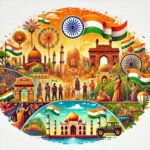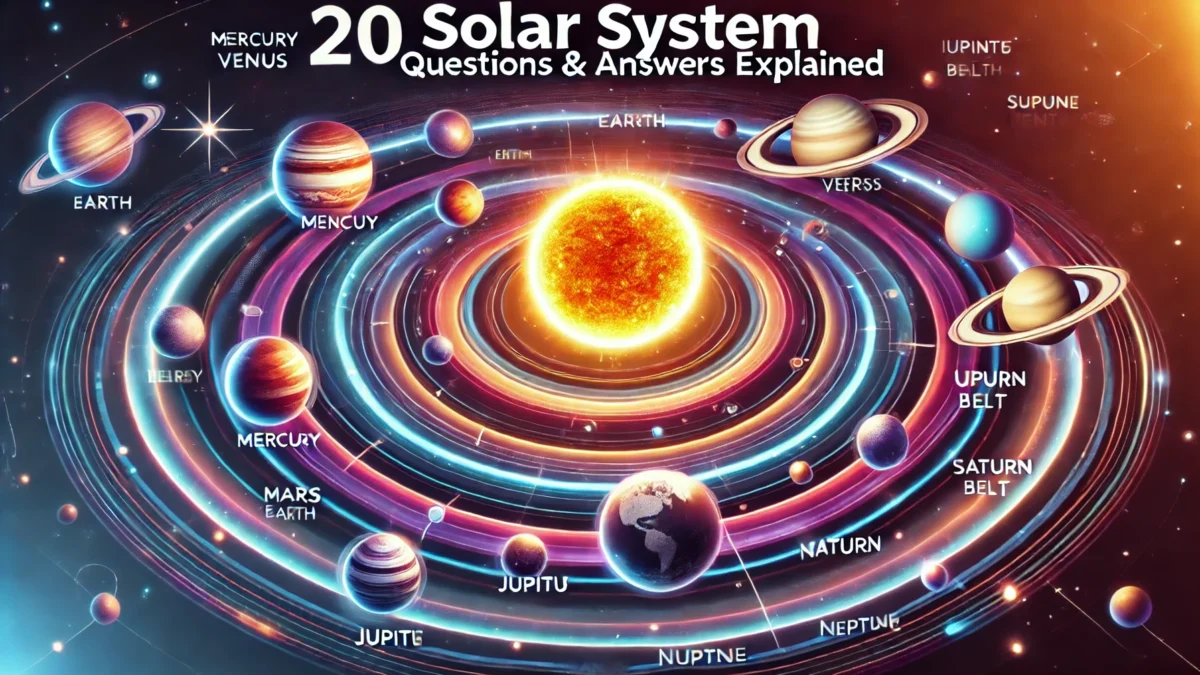
भारत के प्रमुख राष्ट्रीय दिवस: क्यों और कब मनाए जाते हैं
17/11/2024
शिक्षा का महत्व: एक बेहतर भविष्य की ओर मार्ग
24/11/2024यहाँ सौरमंडल पर 20 बहुविकल्पीय प्रश्न उनके उत्तर और व्याख्या के साथ दिए गए हैं:
- सौरमंडल का सबसे बड़ा ग्रह कौन सा है?
A) पृथ्वी
B) बृहस्पति
C) शनि
D) वरुण
उत्तर: B) बृहस्पति
व्याख्या: बृहस्पति सौरमंडल का सबसे बड़ा ग्रह है, जिसका व्यास लगभग 1,39,820 किमी है। यह एक गैस दानव है और इसका गुरुत्वाकर्षण बहुत अधिक है।
- सूर्य के सबसे निकट कौन सा ग्रह है?
A) शुक्र
B) बुध
C) पृथ्वी
D) मंगल
उत्तर: B) बुध
व्याख्या: बुध सूर्य के सबसे निकट स्थित ग्रह है, जिसकी औसत दूरी लगभग 57.9 मिलियन किलोमीटर है।
- सूर्य का मुख्य घटक क्या है?
A) हाइड्रोजन
B) ऑक्सीजन
C) कार्बन
D) नाइट्रोजन
उत्तर: A) हाइड्रोजन
व्याख्या: सूर्य मुख्य रूप से हाइड्रोजन (लगभग 74%) से बना है, जो परमाणु संलयन के दौरान हीलियम में परिवर्तित होता है और ऊर्जा उत्पन्न करता है।
- सौरमंडल में सबसे अधिक चंद्रमा किस ग्रह के हैं?
A) बृहस्पति
B) शनि
C) अरुण
D) वरुण
उत्तर: B) शनि
व्याख्या: वर्तमान में शनि के 145 पुष्ट चंद्रमा हैं, जो बृहस्पति से अधिक हैं।
- सौरमंडल का सबसे बड़ा चंद्रमा कौन सा है?
A) टाइटन
B) गैनीमेड
C) कैलिस्टो
D) यूरोपा
उत्तर: B) गैनीमेड
व्याख्या: गैनीमेड बृहस्पति का चंद्रमा है और यह सौरमंडल का सबसे बड़ा चंद्रमा है। यह ग्रह बुध से भी बड़ा है।
- किस ग्रह को “लाल ग्रह” कहा जाता है?
A) शुक्र
B) मंगल
C) बृहस्पति
D) बुध
उत्तर: B) मंगल
व्याख्या: मंगल को “लाल ग्रह” कहा जाता है क्योंकि इसकी सतह पर लोहे का ऑक्साइड (जंग) पाया जाता है, जो इसे लाल रंग का बनाता है।
- प्लूटो को ग्रह क्यों नहीं माना जाता है?
A) यह बहुत छोटा है।
B) यह सूर्य की परिक्रमा नहीं करता।
C) यह अपनी कक्षा साफ नहीं करता।
D) यह बर्फ से बना है।
उत्तर: C) यह अपनी कक्षा साफ नहीं करता।
व्याख्या: 2006 में, अंतरराष्ट्रीय खगोलीय संघ ने ग्रहों की परिभाषा बदली। प्लूटो को इसलिए ग्रह से हटा दिया गया क्योंकि यह अपनी कक्षा में मलबा साफ नहीं करता।
- क्षुद्रग्रह घेरा (Asteroid Belt) मुख्य रूप से किनके बीच स्थित है?
A) पृथ्वी और मंगल
B) मंगल और बृहस्पति
C) बृहस्पति और शनि
D) शनि और अरुण
उत्तर: B) मंगल और बृहस्पति
व्याख्या: क्षुद्रग्रह घेरा मंगल और बृहस्पति की कक्षाओं के बीच स्थित है और इसमें प्रारंभिक सौरमंडल के शिलाखंड शामिल हैं।
- कौन सा ग्रह अपनी कक्षा के सापेक्ष अपने किनारे पर घूमता है?
A) शुक्र
B) वरुण
C) अरुण
D) शनि
उत्तर: C) अरुण
व्याख्या: अरुण लगभग 98 डिग्री झुकाव के साथ अपने किनारे पर घूमता है। यह संभवतः किसी बड़े पिंड से टकराने के कारण हुआ होगा।
- उस सीमा को क्या कहते हैं जहाँ सूर्य की सौर वायु तारों के मध्य स्थान से मिलती है?
A) हेलियोपॉज
B) क्षुद्रग्रह घेरा
C) काइपर बेल्ट
D) ओर्ट बादल
उत्तर: A) हेलियोपॉज
व्याख्या: हेलियोपॉज वह सीमा है जहाँ सूर्य की सौर वायु तारों के मध्य के माध्यम द्वारा रोकी जाती है।
- सौरमंडल में सबसे छोटा दिन किस ग्रह का है?
A) पृथ्वी
B) बृहस्पति
C) शनि
D) मंगल
उत्तर: B) बृहस्पति
व्याख्या: बृहस्पति का दिन सबसे छोटा है, जो लगभग 9 घंटे 55 मिनट का होता है।
- सौरमंडल का सबसे छोटा ग्रह कौन सा है?
A) मंगल
B) बुध
C) शुक्र
D) वरुण
उत्तर: B) बुध
व्याख्या: बुध सौरमंडल का सबसे छोटा ग्रह है, जिसका व्यास 4,880 किमी है।
- किस ग्रह की रिंग प्रणाली सबसे बड़ी है?
A) बृहस्पति
B) शनि
C) वरुण
D) अरुण
उत्तर: B) शनि
व्याख्या: शनि की रिंग प्रणाली सबसे बड़ी और प्रमुख है। यह बर्फ और चट्टानों के कणों से बनी है।
- किस ग्रह को पृथ्वी का “जुड़वां” कहा जाता है?
A) मंगल
B) शुक्र
C) बृहस्पति
D) वरुण
उत्तर: B) शुक्र
व्याख्या: शुक्र को पृथ्वी का जुड़वां कहा जाता है क्योंकि इसका आकार, द्रव्यमान और संरचना पृथ्वी के समान है।
- धूमकेतु मुख्य रूप से किससे बने होते हैं?
A) चट्टान और धातु
B) बर्फ और धूल
C) गैस
D) ठोस लोहा
उत्तर: B) बर्फ और धूल
व्याख्या: धूमकेतु बर्फ, धूल और चट्टानों से बने होते हैं, इसलिए इन्हें “गंदे हिमगोले” कहा जाता है।
- किस ग्रह की सतह का तापमान इतना गर्म है कि सीसा पिघल सकता है?
A) बुध
B) शुक्र
C) मंगल
D) बृहस्पति
उत्तर: B) शुक्र
व्याख्या: शुक्र का वातावरण मुख्यतः कार्बन डाइऑक्साइड से बना है, जिससे ग्रीनहाउस प्रभाव के कारण इसका तापमान लगभग 475°C तक पहुंच जाता है।
- काइपर बेल्ट क्या है?
A) वरुण के पार बर्फीले पिंडों का क्षेत्र
B) मंगल और बृहस्पति के बीच का क्षुद्रग्रह घेरा
C) सौरमंडल की बाहरी सीमा
D) शनि के चारों ओर का घेरा
उत्तर: A) वरुण के पार बर्फीले पिंडों का क्षेत्र
व्याख्या: काइपर बेल्ट वरुण के पार बर्फीले पिंडों का क्षेत्र है, जिसमें प्लूटो जैसे बौने ग्रह शामिल हैं।
- सूर्य ग्रहण कैसे होता है?
A) पृथ्वी सूर्य और चंद्रमा के बीच आती है।
B) चंद्रमा सूर्य और पृथ्वी के बीच आता है।
C) सूर्य पृथ्वी से दूर हो जाता है।
D) पृथ्वी की छाया चंद्रमा पर पड़ती है।
उत्तर: B) चंद्रमा सूर्य और पृथ्वी के बीच आता है।
व्याख्या: सूर्य ग्रहण तब होता है जब चंद्रमा सूर्य की रोशनी को पृथ्वी तक पहुँचने से रोक देता है।
- किस ग्रह पर “महान लाल धब्बा” (Great Red Spot) है?
A) शनि
B) मंगल
C) बृहस्पति
D) शुक्र
उत्तर: C) बृहस्पति
व्याख्या: महान लाल धब्बा बृहस्पति पर एक विशाल तूफान है, जो सैकड़ों वर्षों से चल रहा है।
- सौरमंडल का सबसे दूर का ज्ञात क्षेत्र कौन सा है?
A) काइपर बेल्ट
B) ओर्ट बादल
C) क्षुद्रग्रह घेरा
D) हेलियोपॉज
उत्तर: B) ओर्ट बादल
व्याख्या = ओर्ट बादल बर्फीले पिंडों का एक गोलाकार खोल है, जो सौरमंडल का सबसे दूरस्थ क्षेत्र है। यह सूर्य से लगभग 1,00,000 खगोलीय इकाइयों (AU) की दूरी तक फैला हुआ है।
Here are 20 multiple-choice questions about the solar system, along with answers and explanations:
- What is the largest planet in the solar system?
A) Earth
B) Jupiter
C) Saturn
D) Neptune
Answer: B) Jupiter
Explanation: Jupiter is the largest planet in the solar system, with a diameter of about 139,820 km. It is a gas giant and has a massive gravitational pull.
- Which planet is closest to the Sun?
A) Venus
B) Mercury
C) Earth
D) Mars
Answer: B) Mercury
Explanation: Mercury is the closest planet to the Sun, with an average distance of about 57.9 million kilometers.
- What is the main component of the Sun?
A) Hydrogen
B) Oxygen
C) Carbon
D) Nitrogen
Answer: A) Hydrogen
Explanation: The Sun is primarily composed of hydrogen (about 74%), which undergoes nuclear fusion to form helium, releasing energy.
- Which planet has the highest number of moons?
A) Jupiter
B) Saturn
C) Uranus
D) Neptune
Answer: B) Saturn
Explanation: As of recent observations, Saturn has 145 confirmed moons, surpassing Jupiter.
- What is the name of the largest moon in the solar system?
A) Titan
B) Ganymede
C) Callisto
D) Europa
Answer: B) Ganymede
Explanation: Ganymede, a moon of Jupiter, is the largest moon in the solar system. It is even larger than the planet Mercury.
- Which planet is known as the “Red Planet”?
A) Venus
B) Mars
C) Jupiter
D) Mercury
Answer: B) Mars
Explanation: Mars is called the “Red Planet” because of its reddish appearance due to iron oxide (rust) on its surface.
- What is the main reason Pluto is no longer considered a planet?
A) It is too small.
B) It does not orbit the Sun.
C) It does not clear its orbit.
D) It is made of ice.
Answer: C) It does not clear its orbit.
Explanation: In 2006, the International Astronomical Union redefined planets. Pluto was demoted because it does not clear its orbital path of debris.
- What is the asteroid belt primarily located between?
A) Earth and Mars
B) Mars and Jupiter
C) Jupiter and Saturn
D) Saturn and Uranus
Answer: B) Mars and Jupiter
Explanation: The asteroid belt lies between the orbits of Mars and Jupiter and contains rocky remnants from the early solar system.
- Which planet rotates on its side relative to its orbit?
A) Venus
B) Neptune
C) Uranus
D) Saturn
Answer: C) Uranus
Explanation: Uranus rotates on its side with an axial tilt of about 98 degrees, possibly due to a collision with a large object.
- What is the term for the boundary where the Sun’s solar wind meets interstellar space?
A) Heliopause
B) Asteroid Belt
C) Kuiper Belt
D) Oort Cloud
Answer: A) Heliopause
Explanation: The heliopause is the boundary where the solar wind from the Sun is stopped by the interstellar medium.
- Which planet has the shortest day in the solar system?
A) Earth
B) Jupiter
C) Saturn
D) Mars
Answer: B) Jupiter
Explanation: Jupiter has the shortest day, rotating once every 9 hours and 55 minutes.
- What is the smallest planet in the solar system?
A) Mars
B) Mercury
C) Venus
D) Neptune
Answer: B) Mercury
Explanation: Mercury is the smallest planet in the solar system, with a diameter of 4,880 km.
- Which planet has the most extensive ring system?
A) Jupiter
B) Saturn
C) Neptune
D) Uranus
Answer: B) Saturn
Explanation: Saturn’s rings are the most extensive and visible, made of ice and rock particles.
- Which planet is known as Earth’s twin?
A) Mars
B) Venus
C) Jupiter
D) Neptune
Answer: B) Venus
Explanation: Venus is called Earth’s twin because of its similar size, mass, and composition.
- What are comets primarily made of?
A) Rocks and metals
B) Ice and dust
C) Gases
D) Solid iron
Answer: B) Ice and dust
Explanation: Comets are made of ice, dust, and rocky material, earning them the nickname “dirty snowballs.”
- Which planet has a surface temperature hot enough to melt lead?
A) Mercury
B) Venus
C) Mars
D) Jupiter
Answer: B) Venus
Explanation: Venus has a thick atmosphere of carbon dioxide, leading to extreme greenhouse heating, with surface temperatures around 475°C (887°F).
- What is the Kuiper Belt?
A) A region of icy bodies beyond Neptune
B) The asteroid belt between Mars and Jupiter
C) The outer boundary of the solar system
D) A ring around Saturn
Answer: A) A region of icy bodies beyond Neptune
Explanation: The Kuiper Belt is a region beyond Neptune filled with icy bodies, including dwarf planets like Pluto.
- What causes a solar eclipse?
A) The Earth passes between the Sun and the Moon.
B) The Moon passes between the Sun and Earth.
C) The Sun moves away from Earth.
D) The Earth’s shadow falls on the Moon.
Answer: B) The Moon passes between the Sun and Earth.
Explanation: A solar eclipse occurs when the Moon blocks the Sun’s light from reaching Earth.
- Which planet has the Great Red Spot?
A) Saturn
B) Mars
C) Jupiter
D) Venus
Answer: C) Jupiter
Explanation: The Great Red Spot is a massive storm on Jupiter that has existed for hundreds of years.
- What is the most distant known region of the solar system?
A) Kuiper Belt
B) Oort Cloud
C) Asteroid Belt
D) Heliopause
Answer: B) Oort Cloud
Explanation: The Oort Cloud is a spherical shell of icy objects that marks the farthest region of the solar system, extending about 100,000 AU from the Sun.

